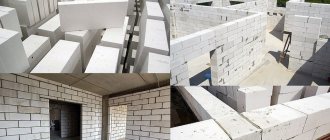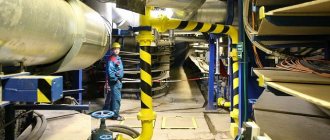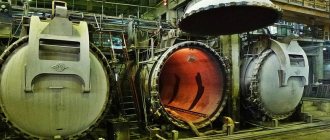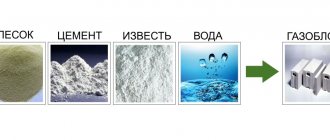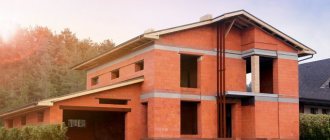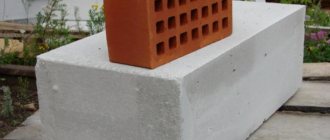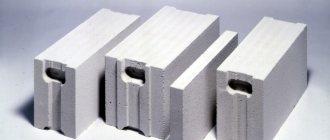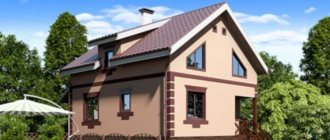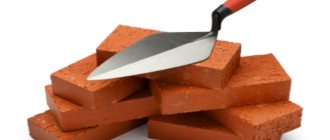Advantages and disadvantages of aerated concrete and gas silicate blocks
Due to the similar structure and chemical composition of aerated block and gas silicate, both materials have the same advantages:
- High rate of heat and sound insulation.
- No harmful impurities for humans.
- Ease and speed of installation. The construction period is reduced several times. There are many video reviews on Youtube where one person builds the walls of a one-story house covering 150 km² during his vacation.
- Strict geometry of shapes. The deviation of blocks from a good manufacturer is no more than 1 mm.
- Not susceptible to combustion processes.
- Possibility of processing and cutting using a hand saw.
- High coefficient of vapor permeability.
- Thanks to a thin layer of masonry joint, “cold bridges” are minimized.
- Frost resistance.
- Acceptable prices.
- Standard sizes for all manufacturers make the process of independently calculating the material simple.
The situation is similar with disadvantages. They are identical:
- High hygroscopicity (the ability to absorb moisture from the air, inherent due to the cellular structure).
- Increased fragility. A wall made of aerated concrete or gas silicate reacts sharply to the slightest vibrations of the foundation.
- Mandatory priming before plastering. Otherwise, the applied layer will peel off in the first year of operation.
- Low compressive and flexural strength.
The last disadvantage of porous concrete is that special hardware is used as fasteners for shelves, mirrors and other things, the price of which is higher than usual.
Material characteristics
Despite their external similarity, materials have several distinctive features that affect their subsequent purpose. In particular, the difference occurs even at the stage of preparing the mixture. Aerated concrete is made from cement, gas silicate is made from lime. This results in a difference in the color of the finished product.
Other technical and operational characteristics of materials differ in the following parameters:
- A more uniform distribution of cells in the block structure, providing a high strength index.
- The weight of aerated silicate is less than aerated concrete, which reduces the load on the foundation.
- Aerated concrete is inferior in terms of thermal insulation.
- Gas silicate absorbs moisture from the atmosphere worse.
Expert opinion Vitaly Kudryashov builder, aspiring author
Ask a Question
Both types of blocks have smooth, strict linear dimensions. They are laid out on a special glue, the seam thickness of which does not exceed 2-5 mm. The constructed walls are smooth, which eliminates the need for subsequent cladding. The use of the composition reduces the thickness of the masonry joint, reducing the “cold bridge”.
Scope of application
Foam concrete and gas silicate blocks are widely used in various fields of construction
.
Both internal and external walls of houses are built from this material. Most modern high-rise buildings are built from this material. This is due to the light weight of the blocks, which can significantly reduce the load on the main frame and foundation of the house
, while the blocks are strong enough not to worry about the integrity of the ceilings and walls.
Foamed concrete is also used in the construction of many auxiliary, industrial and agricultural buildings. The only exception is buildings in which there is constant high humidity
, such as indoor swimming pools, saunas and steam baths.
Despite the fact that the permissible humidity standards for the use of cellular concrete are 75%, if a level of more than 60% is expected, then foam concrete and gas silicate blocks are not recommended. In some cases , it is allowed to use this material if after installation they will be protected from steam
moisture-proofing materials that can protect the structure itself from the negative effects of high humidity.
Gas silicate blocks are used somewhat more often in the construction of houses, since in addition to increased strength they are distinguished by perfectly smooth surfaces, which allows you to create smooth masonry and subsequently spend less time and effort on its cladding.
Gas silicate is joined with a simple cement mortar and a special glue, as a result of which the seams between the blocks remain thinner. This reduces cold bridges, improving the thermal stability of the entire structure.
Considering the difference in density and strength of materials, foam concrete is recommended to be used only in small buildings
, for example, in private houses up to two floors high. It is not recommended to use it as load-bearing structures, and it is also better to combine foam concrete with brick or monolithic concrete columns.
Construction of high-rise buildings using gas silicate blocks is permitted
, as well as load-bearing supports in small buildings, without additional reinforcement with concrete belts.
Of all types of building blocks, aerated concrete and gas silicate are most often confused; they have a similar structure and characteristics, and at first glance there is no difference between them. It is impossible to say unequivocally which of these materials is better; they are not universal and are not without drawbacks. But each of them has an optimal scope of application.
The prefix “gas-” implies that these grades of concrete obtain their porous structure by adding chemicals to the solution that produce bubbles, both during heat treatment and under natural conditions. The final diameter of the cells varies from 1 to 3 mm, they have a regular round shape and are evenly distributed throughout the entire volume, porosity depends on the brand and reaches 80%. This allows the materials to retain heat well and insulate rooms from extraneous noise with minimal load on the foundation.
The differences lie in the composition and manufacturing technology. The raw materials include about 24% lime and 62% ground quartz sand, the rest is aluminum powder and alkaline additives. The mixture is poured into molds and undergoes mandatory autoclave treatment; porosization of the gas silicate begins at the moment of steaming under excess pressure. The resulting brick is cut into pieces of the required size using strings; the products are characterized by high geometric accuracy. Due to lime, they most often have a white color.
The composition of the mixtures includes at least 50% cement, the remaining components in addition to aluminum powder are different: from natural and environmentally friendly finely ground sands and minerals (including limestone) to cheap recycled products (ash, slag). This brand of cellular concrete is produced both by autoclave processing and by natural hardening or electrical heating. At the same time, steaming aerated concrete makes it possible to improve its strength and achieve the required performance characteristics, but the process of cell formation itself begins earlier, at the moment of connecting the components. The hydration (non-autoclave) variety hardens under pressure equal to atmospheric pressure; this manufacturing method is cheaper, but the process itself takes at least 28 days (standard time for cement hydration).
Manufacturing method
The main raw material used for the production of porous concrete is cement.
In the production of gas silicate it is replaced by lime. At the initial stage, the main component is mixed with water and sand cleared of impurities. A gas-forming substance (aluminum powder) is added to the finished composition. The finished mixture is poured into molds.
Expert opinion Vitaly Kudryashov builder, aspiring author
Ask a Question
The subsequent stage of processing aerated concrete occurs according to different principles, resulting in 2 building materials with different technical characteristics.
The mold with the mixture is placed in an autoclave oven, where it is dried under high pressure. During hardening, gases are released, then many cells are formed in the structure of the block through which vapors escape. This technique increases strength and density. The resulting material is actively used in construction as the main material in the construction of load-bearing walls.
The second method of making aerated concrete is to dry it naturally. The resulting cellular block is used in the field of construction and finishing works, in particular, for insulating building facades.
Expert opinion Vitaly Kudryashov builder, aspiring author
Ask a Question
Healthy! In fact, there are concepts on the market: aerated concrete/gas silicate, autoclaved, non-autoclaved. Confusion in terms is most often caused by incompetent sellers who do not attach importance to the names of different materials.
Conclusion
In fact, both aerated concrete and gas silicate blocks are perfect for building a one- or two-story house, especially since domestic manufacturers themselves sometimes pass one off as the other. In terms of their characteristics, they do not have any radical or fundamental differences, but they still have some features. So, gas silicate blocks are stronger, but you have to pay for this strength, but otherwise all the characteristics are very similar, and the difference between them is literally insignificant.
The modern market for building materials is so large that sometimes it is easy to get lost in this assortment, and it is also difficult to make the right choice. A comparison of their advantages and disadvantages will help you choose which is better - foam concrete or gas silicate. There are very few main conditions, but the quality of the constructed building largely depends on them.
What are the differences between aerated concrete and gas silicate blocks
The average values of aerated concrete and gas silicate are presented in the table.
| Characteristic | Aerated concrete | Gas silicate |
| Water absorption coefficient, % | 16-25 | 25-30 |
| Number of complete freezing cycles | 35 | 35 |
| Possible density grades | D150-D600 | D300-D900 |
| Vapor permeability coefficient, mg/m*h*MPa | 0,12 | 0,17-0,25 |
| Thermal conductivity coefficient, W/ °C*m² | 0,15-0,39 | 0,11-0,16 |
| Compressive strength coefficient, MPa | 1,5-2,5 | 1-5 |
| Masonry thickness with equal thermal conductivity, mm | 400 | 300 |
Which block is better to choose for building a house: aerated concrete or gas silicate?
After following a comparative analysis of materials, we can conclude what is better to use for building a house: aerated concrete or gas silicate. Please note that gas silicate fired in an autoclave oven will differ in workmanship, which affects its price. Aerated concrete blocks of lower density are cheaper, but they have a low strength index and are quite fragile. But they have high thermal conductivity.
Non-autoclaved aerated concrete is less durable and is significantly inferior in quality to gas silicate. However, the advantage of the former here is the simple manufacturing technique. The ability to set up the production of aerated concrete blocks directly on the construction site can significantly reduce financial costs, which can be considered as a significant advantage of the material. If we assess the situation more soberly, gas silicate is superior to gas block in all respects. The only thing in which it is inferior is hydrophobicity. The presence of this characteristic limits use to a maximum permissible humidity level of 60%.
Advantages of gas silicate over aerated concrete
Gas silicate or aerated concrete: which one is better? This issue must be resolved depending on the specific situation. The air bubbles of gas silicate blocks are distributed more evenly throughout their volume, so they are somewhat stronger. Thus, as a result of building a house, gas silicate walls do not shrink as often and cracks appear on them less often. Multi-storey buildings with load-bearing partitions are built from this block. The gas silicate block, due to the fact that air bubbles are correctly located in it, has good soundproofing properties. If the building has high noise requirements, you need to choose gas silicate. It has good thermal insulation qualities.
To build a house, instead of ordinary bricks, it is better to take gas silicate products. The work will be much cheaper. The large dimensions and low weight of gas silicate blocks contribute to faster construction.
